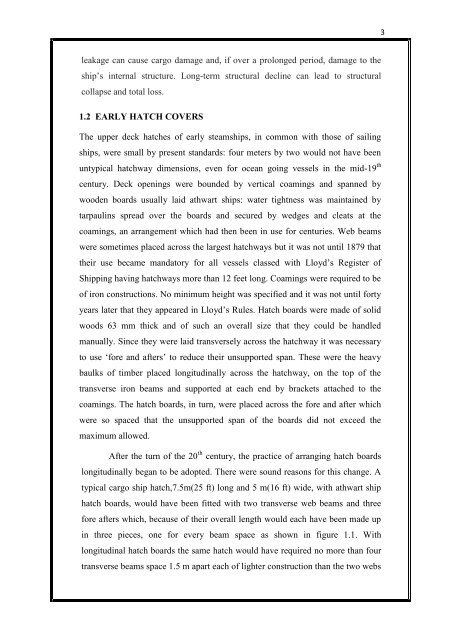Single pull macgregor type hatch cover.pdf - Cochin University of ...
Single pull macgregor type hatch cover.pdf - Cochin University of ...
Single pull macgregor type hatch cover.pdf - Cochin University of ...
Create successful ePaper yourself
Turn your PDF publications into a flip-book with our unique Google optimized e-Paper software.
leakage can cause cargo damage and, if over a prolonged period, damage to the<br />
ship’s internal structure. Long-term structural decline can lead to structural<br />
collapse and total loss.<br />
1.2 EARLY HATCH COVERS<br />
The upper deck <strong>hatch</strong>es <strong>of</strong> early steamships, in common with those <strong>of</strong> sailing<br />
ships, were small by present standards: four meters by two would not have been<br />
untypical <strong>hatch</strong>way dimensions, even for ocean going vessels in the mid-19 th<br />
century. Deck openings were bounded by vertical coamings and spanned by<br />
wooden boards usually laid athwart ships: water tightness was maintained by<br />
tarpaulins spread over the boards and secured by wedges and cleats at the<br />
coamings, an arrangement which had then been in use for centuries. Web beams<br />
were sometimes placed across the largest <strong>hatch</strong>ways but it was not until 1879 that<br />
their use became mandatory for all vessels classed with Lloyd’s Register <strong>of</strong><br />
Shipping having <strong>hatch</strong>ways more than 12 feet long. Coamings were required to be<br />
<strong>of</strong> iron constructions. No minimum height was specified and it was not until forty<br />
years later that they appeared in Lloyd’s Rules. Hatch boards were made <strong>of</strong> solid<br />
woods 63 mm thick and <strong>of</strong> such an overall size that they could be handled<br />
manually. Since they were laid transversely across the <strong>hatch</strong>way it was necessary<br />
to use ‘fore and afters’ to reduce their unsupported span. These were the heavy<br />
baulks <strong>of</strong> timber placed longitudinally across the <strong>hatch</strong>way, on the top <strong>of</strong> the<br />
transverse iron beams and supported at each end by brackets attached to the<br />
coamings. The <strong>hatch</strong> boards, in turn, were placed across the fore and after which<br />
were so spaced that the unsupported span <strong>of</strong> the boards did not exceed the<br />
maximum allowed.<br />
After the turn <strong>of</strong> the 20 th century, the practice <strong>of</strong> arranging <strong>hatch</strong> boards<br />
longitudinally began to be adopted. There were sound reasons for this change. A<br />
typical cargo ship <strong>hatch</strong>,7.5m(25 ft) long and 5 m(16 ft) wide, with athwart ship<br />
<strong>hatch</strong> boards, would have been fitted with two transverse web beams and three<br />
fore afters which, because <strong>of</strong> their overall length would each have been made up<br />
in three pieces, one for every beam space as shown in figure 1.1. With<br />
longitudinal <strong>hatch</strong> boards the same <strong>hatch</strong> would have required no more than four<br />
transverse beams space 1.5 m apart each <strong>of</strong> lighter construction than the two webs<br />
3

















